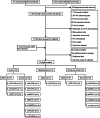The association between genetic polymorphisms in ABCG2 and SLC2A9 and urate: an updated systematic review and meta-analysis
- PMID: 33087043
- PMCID: PMC7580000
- DOI: 10.1186/s12881-020-01147-2
The association between genetic polymorphisms in ABCG2 and SLC2A9 and urate: an updated systematic review and meta-analysis
Abstract
Background: Replication studies showed conflicting effects of ABCG2 and SLC2A9 polymorphisms on gout and serum urate. This meta-analysis therefore aimed to pool their effects across studies.
Methods: Studies were located from MEDLINE and Scopus from inception to 17th June 2018. Observational studies in adults with any polymorphism in ABCG2 or SLC2A9, and outcome including gout, hyperuricemia, and serum urate were included for pooling. Data extractions were performed by two independent reviewers. Genotype effects were pooled stratified by ethnicity using a mixed-effect logistic model and a multivariate meta-analysis for dichotomous and continuous outcomes.
Results: Fifty-two studies were included in the analysis. For ABCG2 polymorphisms, mainly studied in Asians, carrying 1-2 minor-allele-genotypes of rs2231142 and rs72552713 were respectively about 2.1-4.5 and 2.5-3.9 times higher odds of gout than non-minor-allele-genotypes. The two rs2231142-risk-genotypes also had higher serum urate about 11-18 μmol/l. Conversely, carrying 1-2 minor alleles of rs2231137 was about 36-57% significantly lower odds of gout. For SLC2A9 polymorphisms, mainly studied in Caucasians, carrying 1-2 minor alleles of rs1014290, rs6449213, rs6855911, and rs7442295 were about 25-43%, 31-62%, 33-64%, and 35-65% significantly lower odds of gout than non-minor-allele-genotypes. In addition, 1-2 minor-allele-genotypes of the latter three polymorphisms had significantly lower serum urate about 20-49, 21-51, and 18-54 μmol/l than non-minor-allele-genotypes.
Conclusions: Our findings should be useful in identifying patients at risk for gout and high serum urate and these polymorphisms may be useful in personalized risk scores.
Trial registration: PROSPERO registration number: CRD42018105275 .
Keywords: ABCG2; Gout; Hyperuricemia; Meta-analysis; SLC2A9; Single nucleotide polymorphism; Urate.
Conflict of interest statement
The authors declare that they have no competing interests.
Figures




Similar articles
-
Pleiotropic effect of the ABCG2 gene in gout: involvement in serum urate levels and progression from hyperuricemia to gout.Arthritis Res Ther. 2020 Mar 12;22(1):45. doi: 10.1186/s13075-020-2136-z. Arthritis Res Ther. 2020. PMID: 32164793 Free PMC article.
-
Trans-ancestral dissection of urate- and gout-associated major loci SLC2A9 and ABCG2 reveals primate-specific regulatory effects.J Hum Genet. 2021 Feb;66(2):161-169. doi: 10.1038/s10038-020-0821-z. Epub 2020 Aug 10. J Hum Genet. 2021. PMID: 32778763
-
The prevalence of the gout-associated polymorphism rs2231142 G>T in ABCG2 in a pregnant female Filipino cohort.Clin Rheumatol. 2020 Aug;39(8):2387-2392. doi: 10.1007/s10067-020-04994-9. Epub 2020 Feb 27. Clin Rheumatol. 2020. PMID: 32107664
-
[ROLE OF SLC2A9 AND ABCG2 GENE POLYMORPHISMS IN ORIGIN OF HYPERURICEMIA AND GOUT].Georgian Med News. 2016 Mar;(252):79-83. Georgian Med News. 2016. PMID: 27119840 Review. Russian.
-
The genetic basis of hyperuricaemia and gout.Joint Bone Spine. 2011 Jan;78(1):35-40. doi: 10.1016/j.jbspin.2010.02.027. Epub 2010 May 15. Joint Bone Spine. 2011. PMID: 20472486 Review.
Cited by
-
Genetic polymorphisms and decreased protein expression of ABCG2 urate transporters are associated with susceptibility to gout, disease severity and renal-overload hyperuricemia.Clin Exp Med. 2023 Aug;23(4):1277-1284. doi: 10.1007/s10238-022-00848-7. Epub 2022 Aug 8. Clin Exp Med. 2023. PMID: 35939175 Free PMC article.
-
SLC2A9 rs1014290 Polymorphism is Associated with Prediabetes and Type 2 Diabetes.Int J Endocrinol. 2022 Dec 12;2022:4947684. doi: 10.1155/2022/4947684. eCollection 2022. Int J Endocrinol. 2022. PMID: 36545489 Free PMC article.
-
Association between glucokinase regulator gene polymorphisms and serum uric acid levels in Taiwanese adolescents.Sci Rep. 2022 Apr 1;12(1):5519. doi: 10.1038/s41598-022-09393-5. Sci Rep. 2022. PMID: 35365700 Free PMC article.
-
Examining an Association of Single Nucleotide Polymorphisms with Hyperuricemia in Chinese Flight Attendants.Pharmgenomics Pers Med. 2022 Jun 8;15:589-602. doi: 10.2147/PGPM.S364206. eCollection 2022. Pharmgenomics Pers Med. 2022. PMID: 35702613 Free PMC article.
-
The association between genetic polymorphisms in GCKR and gout: A systematic review and meta-analysis.Medicine (Baltimore). 2025 May 23;104(21):e42447. doi: 10.1097/MD.0000000000042447. Medicine (Baltimore). 2025. PMID: 40419928 Free PMC article.
References
-
- Pittman JR, Bross MH. Diagnosis and management of gout. Am Fam Physician. 1999;59(7):1799–1806. - PubMed
Publication types
MeSH terms
Substances
LinkOut - more resources
Full Text Sources
Medical

